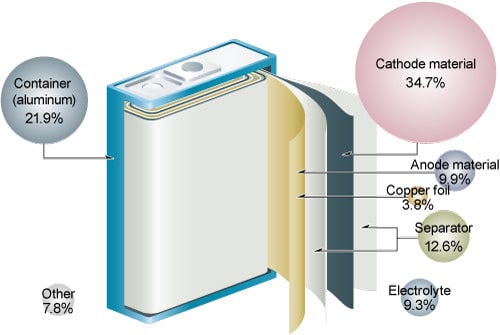Li Ion Battery Materials
A Brief Guide To The Li-Ion Battery Materials

Lithium Ion Battery Materials Suppliers | Image Resource : cdn-images-1.medium.com
In the 1970s that li-ion batteries came into the commercial market. This phenomenon which took place in the early 1970s was succeeded by an attempt to make lithium ion batteries during the 1980s, which would be rechargeable in nature. But the success was blocked due to many challenges one of them being that assembling of the lithium ion battery materials resulted in a number of instabilities. Therefore, an attempt was made to rectify this.
It was understood that the main problem lied in the material that was used as anode. Metallic lithium was not a good element in balancing out the other materials that were used in making the lithium ion batteries. Hence, it was important a good substitute was used in place of metallic lithium.
Since there were no good substitutes for metallic lithium therefore the only solution which remained was to make sure that a more purified version was used than before. One of the reasons lithium ion forms one of the most crucial parts in li ion battery materials is because it not only provides a massive boost of energy compared to other kind of metals but also is light weight and has great electrochemical tendencies.
It was understood that the main problem lied in the material that was used as anode. Metallic lithium was not a good element in balancing out the other materials that were used in making the lithium ion batteries. Hence, it was important a good substitute was used in place of metallic lithium.
Since there were no good substitutes for metallic lithium therefore the only solution which remained was to make sure that a more purified version was used than before. One of the reasons lithium ion forms one of the most crucial parts in li ion battery materials is because it not only provides a massive boost of energy compared to other kind of metals but also is light weight and has great electrochemical tendencies.
An Insight To Li-On Battery Materials Used In Present Times
A lithium ion battery consists of four main parts – cathode, anode, electrolytes and separators. Cathode consists of lithium metal oxides, vanadium oxides along with rechargeable lithium oxides. Oxides which are layered in nature tend to contain cobalt and nickel which make it quite crucial in lithium ion batteries. Due to them being very stable in nature even in high voltage range, they are widely used in lithium ion batteries.
Silicon, lithium, graphite and inter-metallics form the main elements which make up the anode li-ion battery materials. If a battery is supposed to last long it must have a great electrolyte that will be capable of withstanding high voltage and temperatures. A separator on the other hand helps in separating each of the electrodes into two different parts.